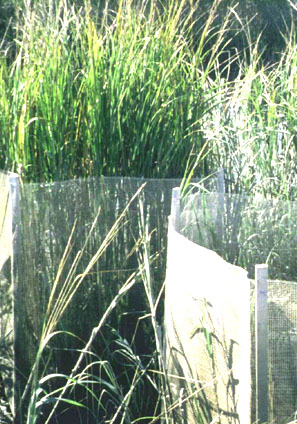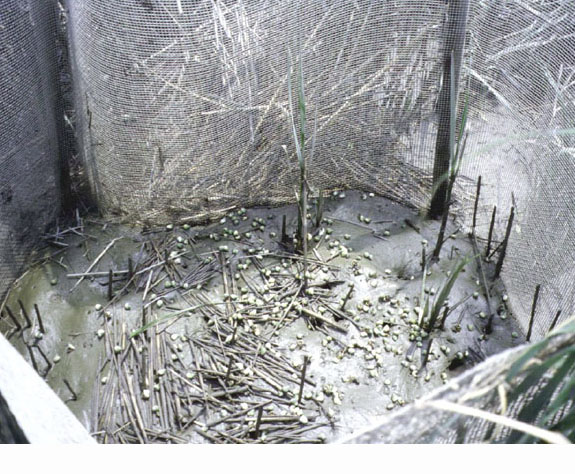Distributed August 5, 2002
For Immediate Release
News Service Contact: Scott Turner
Without blue crabs, southern salt marshes wash away, study finds
Over-harvesting of blue crabs may be triggering the colossal die-off of salt marshes across the southeastern United States, suggests a new study by two Brown University biologists who report their findings in the Proceedings of the National Academy of Sciences.
PROVIDENCE, R.I. — Scale back the harvest of blue crabs now, say Brown University biologists. Their new study suggests that current over-harvesting of blue crabs may be triggering the colossal die-off of salt marshes across the southeastern United States and may one day cause nearby barrier islands to collapse as well.
In experiments along the Virginia and Georgia coasts, the researchers manipulated local populations of animals and found that when blue crabs disappeared from a salt marsh, one of their chief prey – periwinkle snails – flourished. Once free of predation from blue crabs, the periwinkles ate all of the cordgrass in a marsh. Cordgrass dominates the southern marsh, anchoring it and providing its animals with habitat. Without the plants to bind sediment and protect wildlife, the salt marsh ecosystem collapses, the scientists found.
In fact, the study shows that overgrazing by periwinkle snails will convert a southern salt marsh into a barren mudflat within eight months, said lead scientist Brian Silliman.
 |

Two stands of cordgrass in southern salt marsh plots show the effects of snail grazing after eight months. The stand at left had a low density of snails; the stand at right had a high snail density. [Photos: Silliman and Bertness] |
“Cut back the blue crab harvest, because even if we’re half right, the results of over-harvesting could be disastrous,” said Mark Bertness, the project’s senior researcher. Their findings appear in the current Proceedings of the National Academy of Sciences.
Southern salt marshes stretch from Chesapeake Bay to the central-Florida coasts. They are some of the most productive grasslands in the world. The marshes also temper coastal flooding, filter mainland run-off and act as nurseries for commercially important fish and other species. The marshes also protect barrier islands from erosion, and barrier islands buffer the shorelines.
Hundreds of miles of southern salt marshes have died in recent years, particularly in Louisiana and Florida. Silliman and Bertness surveyed several of those dead and dying marshes and found very high densities of periwinkles. “Blue crab populations have been in rapid decline due to over-harvesting,” Bertness said. The strong effects shown in these experiments suggest that southern marshes may already be suffering the consequences, said the authors.
For more than 50 years, ecologists assumed that the half- to three-quarter-inch long black or gray periwinkles ate only dead and dying plant materials in southern salt marshes. But Silliman and Bertness found that unchecked populations of the snail readily ate living cordgrass. Moreover, the greater the nitrogen content of the grass – nitrogen is the prime nutrient in mainland run-off – the more attractive the grass became to the periwinkles.
Marshes can literally choke via a process called eutrophication, which begins with the over-influx of runoff nutrients, mainly from farms and lawns. The nutrients cause excessive aquatic plant growth. Resulting bacteria consume oxygen, especially during warmer months, eventually strangling fish and other species. “This research further suggests that human population growth and eutrophication may accelerate marsh die-offs that are driven by snails consuming the cordgrass,” Bertness said.
The study may cause increased discussion among ecologists. For decades, the prevailing model of marsh ecology was that bottom-up forces, such as currents and nutrient flow, primarily determined plant productivity. This study indicates that a top-down process – the control of grazers (snails) by consumers (crabs) – chiefly establishes the growth of marsh grass.
Silliman and Bertness call this top-down phenomenon a “trophic cascade.” “The discovery of this simple trophic cascade implies that over-harvesting of snail predators, such as blue crabs, may be an important factor contributing to the massive die-off of salt marshes across the southeastern United States,” wrote the authors. The results contribute to a growing body of evidence that similar top-down processes may regulate production in other saltwater ecosystems, including those dominated by kelps, other sea grasses or intertidal algae, they said.
The National Science Foundation, Mellon Foundation and an Environmental Protection Agency/Science To Achieve Results fellowship funded the study.
######





